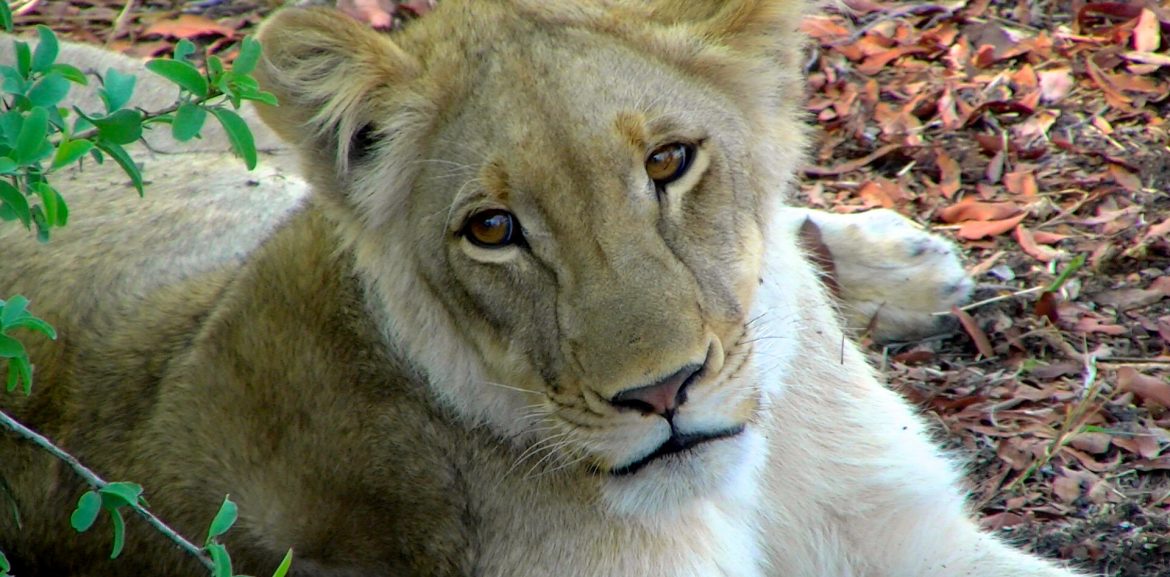Walking with Lions
While staying in Livingstone, Zambia, our group had the opportunity to go on a ‘Lion Walk’- a chance to walk among a pride of lions at a local wildlife park. This activity was organized by a local organization called the African Lion and Environmental Research Trust (ALERT)- an organization leading the effort to curb the decline of lion populations in southern Africa. One-on-one contact with live lions, in Africa, supporting an organization that is trying to preserve the future of the species? Ummmm- sign me up!
ALERT picked us up early in the morning, and, dodging vervet monkeys playing in the road, drove us the 30 minutes or so out to their facility. We pulled up to a safari lodge-styled structure, with a thatched roof and open-air layout. Piling out of the trucks, we saw a barn-like building nearby, with fenced-off pens and a big enclosed area. We were wondering what lived in the barn- what necessitated such tall fences and thick posts- until the trumpet of elephants suddenly filled the air, and two juveniles came scampering out into the yard. They were followed by a lumbering female, out to keep the young ones out of trouble. Monkeys called down to us from the trees above, a warthog scurried across the lawn, and the elephants clambered around inside their enclosure. I began to wonder where, exactly, the lions were hiding out…
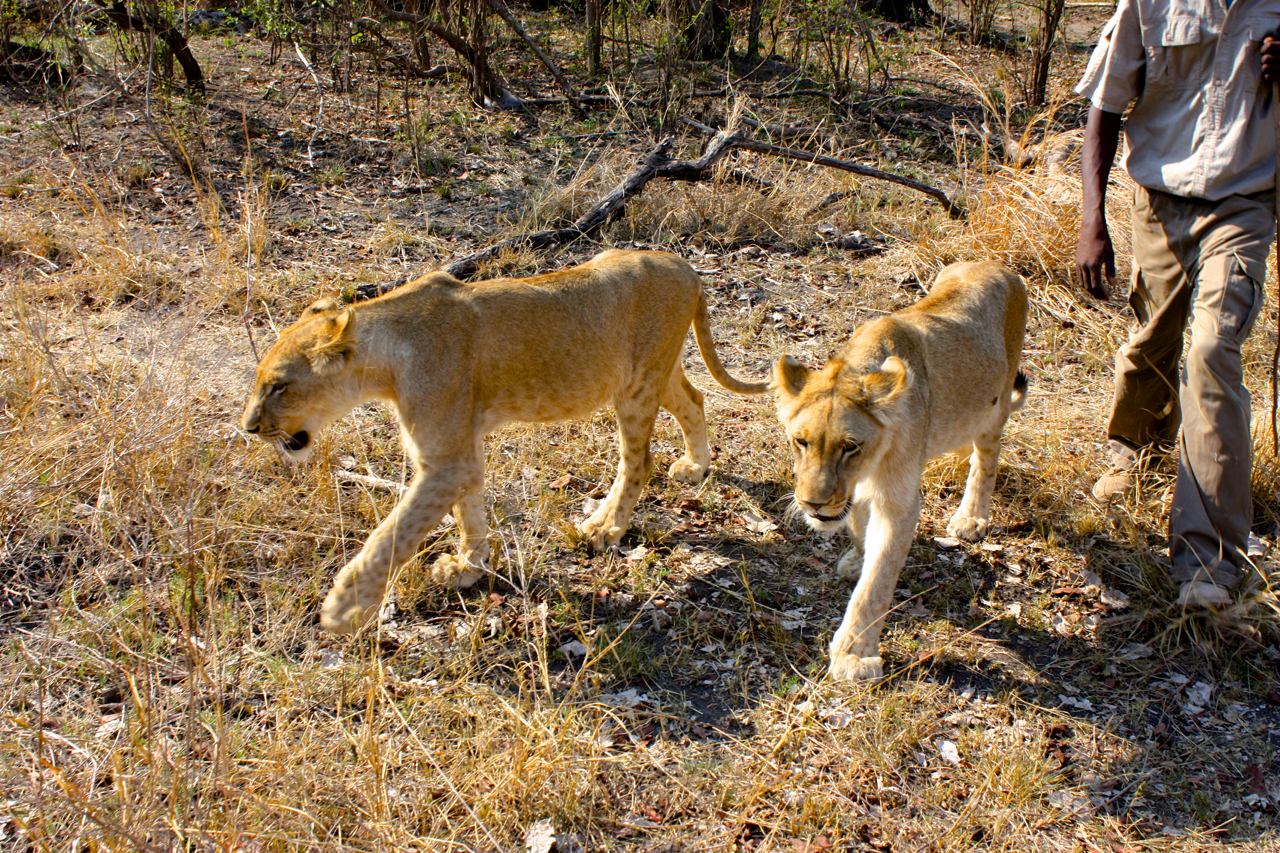
Walking with lions in Zambia
The guides corralled us into the main building, and then split us up into groups of 10 or 12 for the upcoming walk. Each group was matched with a pair of lions, and were given instructions on how to safely and responsibly interact with the big cats. They also explained the long-term goals of the program- the eventual release of lions into the wild that have been raised in ‘captivity’, but have not been influenced by any human contact whatsoever. The plan is that over the span of 3-4 generations of lions living, growing and developing prides in ever-expanding enclosures, combined with a continual decrease in human influence, contact, and interaction, lions descended from the first generation raised in ALERT’s program will be completely wild and naturally prepared for life on their own in the African wilderness. It is a revolutionary idea, one that will take several years of patience and dedication from those that oversee the progress of the program, but if successful, could hold the key to the lion’s long-term survival as a species.
After the introductory talk and safety speech, we loaded up into vans and headed out into the reserve. Spotters had already located the lions, and were ready for us to join them for our Lion Walk experience. I was still a bit unsure about how everything was going to work- we’re just going to walk off the van, and there are going to be lions there, waiting for us? ‘Safe’ lions- i.e. lions that wont want to eat us?? Ok…? I couldn’t decide if I was was comforted or concerned by the high-powered rifles some of the guides were carrying. Better safe than sorry, I supposed… Still, I didn’t want to have to find out.

The guides are so close with the lions- part of the pride...
We crept along the dirt roads through the park, bumping along through potholes and over natural speed bumps. We came around a bend in the road and slowed to a stop, the guides in front calling out the group number that was to get off at that stop. We ended up being the last group to disembark, and as we filed off the bus and out into the warm morning sunshine, we glanced around, looking for the spotters, and the lions. All we could see were a couple of hands raised above the tall grass about 100 meters away. We lined up single-file and slowly made our way over to where the guides were posted.
As we approached the area, our guide called out to the spotters. Apparently, everything was normal, as he nodded at the reply he received and continued to lead us into the tall grass. We crept slowly closer to the clearing, listening, hardly breathing, wondering what we were going to find when we came into the open. I was also wondering what else might be hiding in that tall grass…
Finally, we made our way out of the tall grass and into a clearing, and there they were- two adolescent lionesses, lolling on the ground, playing with each other, swiping their already giant paws at the sticks the spotters were using to distract them from the approaching people. We approached them slowly, with a sense of awe- it was surreal to be so close to one of the most feared predators in Africa, on the ground, with nothing standing between you and them but a few feet of dust and dirt. True, at just under 2 years old, they weren’t fully grown yet, but still, we knew they were strong enough to be dangerous if we didn’t respect them and the situation.

Petting a lion- AWESOME!!!
As we formed a semi-circle around the pair, it became obvious that they weren’t too put off by our presence- they were just lazing around on the ground, rolling here and there, perfectly content to snooze the day away, 20-odd people surrounding them or not. The guides were petting them under the chins, purring at them, letting them smell their hands and shoes. We came to find out that the guides did this for a reason- the cubs had been raised since birth to accept the guides and spotters as ‘members’ of their pride, an everyday presence in their lives. This is what allowed the rest of us to get as close as we were- when the guides accepted us, the lions did as well. In fact, the guides had been trained to establish themselves and behave as the ‘superiors’ in the pride, which reinforced their ability to bring us in close. It was incredible- the lions just accepted it as normal. These were Phase I lions- lions raised with extensive human contact- rescued from the wild, orphaned, etc., and brought in by ALERT to be the founding members of their prides. Their purpose was to both raise awareness of the program through tourist interaction, as well as create the families and offspring that would drive the program into its future phases. They had grown up around people and had been habituated to human contact, so were comfortable with our presence. Regardless, it was still pretty amazing to be THAT close to a couple of pretty big lions.
It was apparent that our two lions were pretty lethargic that day- it seemed all they wanted to do was lay around and sleep. Understandable- they had been fed a substantial meal the night before, and were sleepy due to their full bellies. This actually worked in our favor, as the cubs were content to just lay on the ground while we gathered around for pictures, each of us taking turns crouching down beside them to feel their fur and pet them. The fact that they were ‘tame’ lions that had been raised by the staff of ALERT made no difference- these were live LIONS- one of the most famous and feared predators in the world. I kept having scenes of lions on the hunt flash through my mind… I knew what these animals were capable of when they were hungry, or, even worse, when they felt threatened, and episodes of ‘When Animals Attack’ started forming in my brain. Despite all of this, when my turn came, I slowly stepped forward, crouched down low, and introduced myself to the two powerful cats.

Sleepy lion....
It was amazing to be so close- feeling the coarseness of their fur, seeing the rise and fall of their ribs as they breathed, watching their ears flick here and there, constantly monitoring their surroundings. Incredible. We had been instructed avoid direct eye contact- which can be interpreted as a challenge by the big cats- but I found myself mesmerized by their gaze, frozen by their beautiful golden stare. I didn’t sense aggression, and I wasn’t afraid, but instead seemed to recognize curiosity in those golden eyes- as if she was wondering what was going on in my head. She held my gaze for a second or two, and then was apparently satisfied, as she flopped back onto her side and closed her eyes. I continued to stroke the fur along her side and her back, as her sister snoozed silently a few feet away. After a couple of minutes, it was time to let the next person have a turn, and I slowly stood back up and made my way back into the semi-circle. I had just petted a real-life lion! Amazing…
The guides made sure that everyone had the opportunity to get their photos takes with the lions, and then the walk began. Or at least, it was supposed to- the guides had a bit of difficulty rousing the lions from their mid-morning snoozefest. Eventually they got them to their feet, and we began to slowly amble through the trees and underbrush deeper into the park.
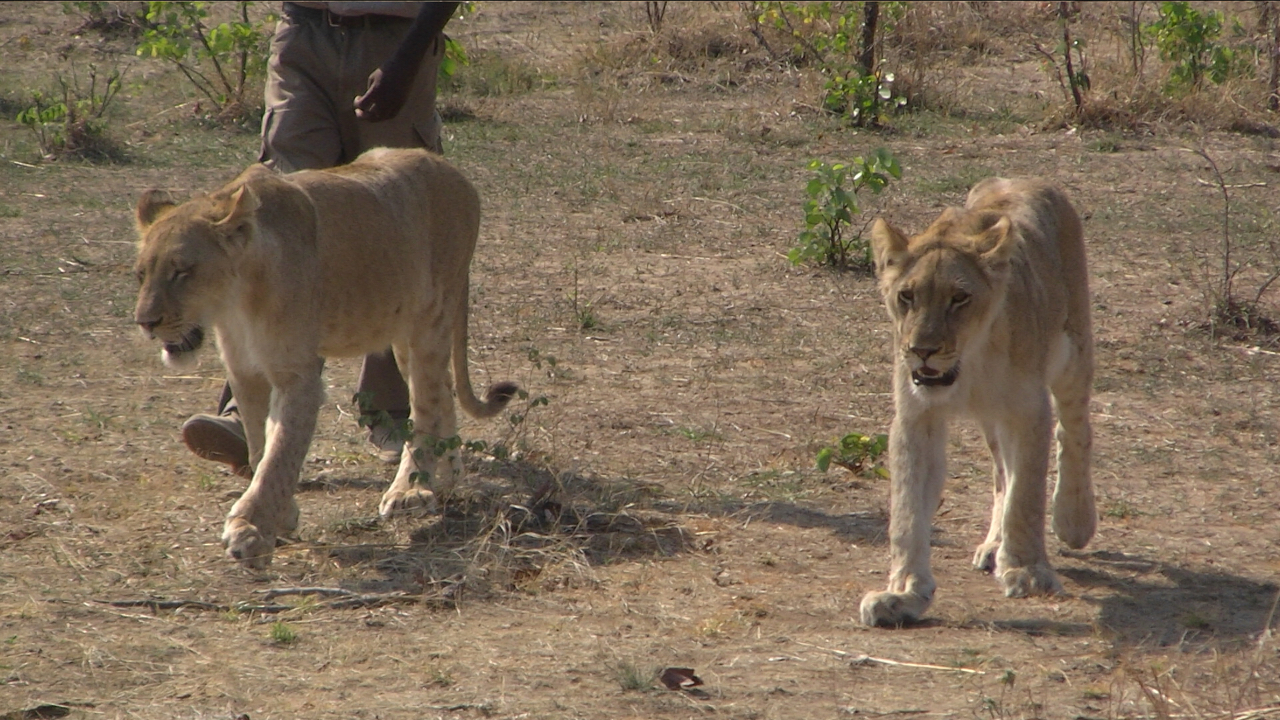
Wandering through the Zambian wilderness...
We spent the next hour or so walking slowly through the park, pausing here and there when the lions decided it was time to flop down again, taking more pictures and gasping at the teeth on display during their gaping yawns. The guides took these pauses in stride, using each as an opportunity to tell us more about the lions, the ALERT program, and the lions’ roles within the grander scheme. Envisioning our two female cubs as two of the founding matriarchs of this grand plan was pretty cool. It felt as if we all- lions, guides, and tourists alike- were on the cusp of something bigger, witnessing the very beginnings of a grand experiment that could hold the survival of the species in its success or failure. It was exciting to consider the prospects of such a revolutionary idea that held such promise. It was pretty awesome.
Eventually, it was time to say goodbye to our lions. A quick last round of photos, and we were heading back to the van. We slowly made our way back to the ALERT center, where there was a MASSIVE breakfast buffet waiting for us. We gorged on bacon and eggs, toast and coffee, potatoes and juice- I was ready for a nap myself after all that food! After breakfast, the staff showed videos they had made of each group’s experience. We discovered that our lions were BY FAR the laziest of the bunch- other group’s had been climbing trees, wrestling with each other, chasing birds and butterflies… It was a tradeoff though- we got the best pictures actually WITH the lions, which was kind of the point, I guess.
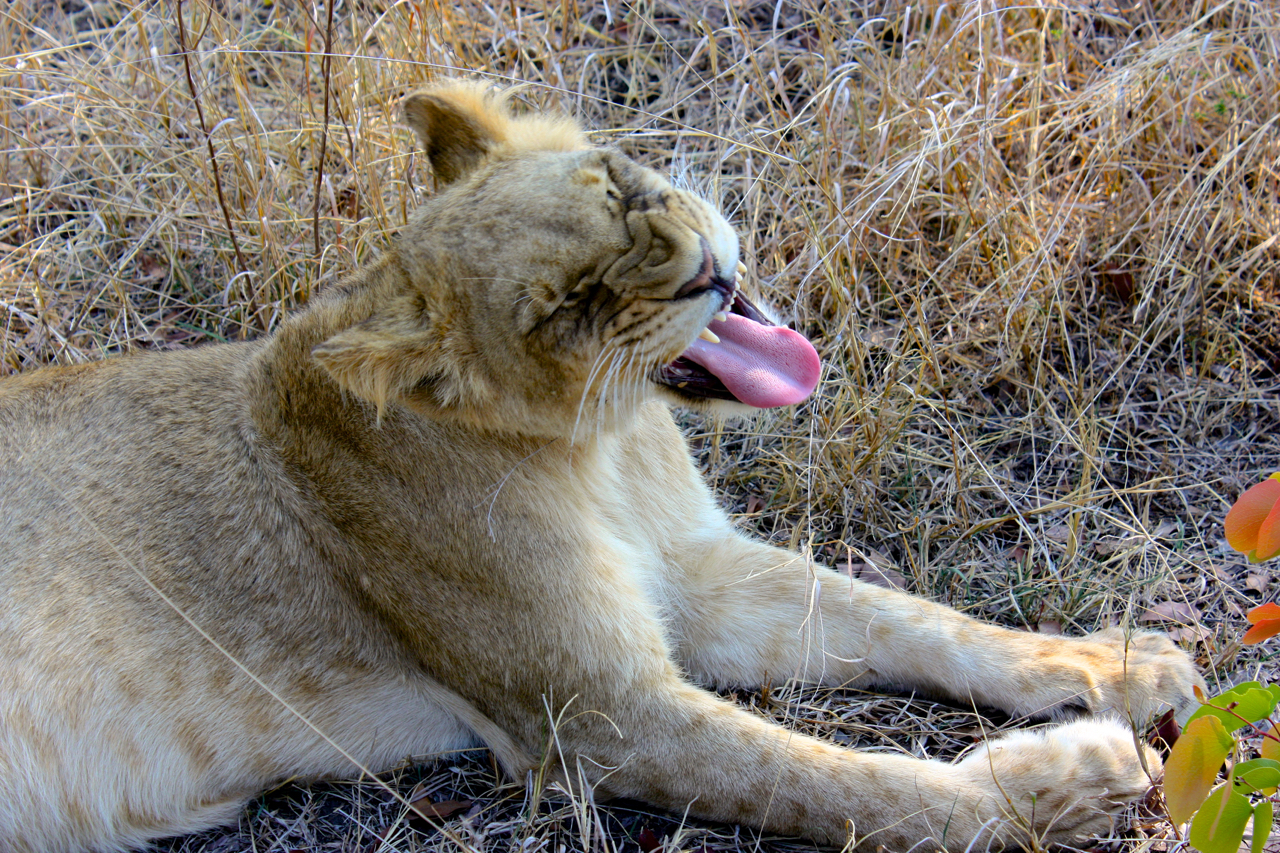
YAWWNNNNNNNN....
There was a ‘Bonus Video‘ at the end of our group’s- a video of our cubs‘ first ‘official kill’, which had happened only the week before… It showed our two lions taking down a small gazelle within the park, just like they would out in the wilds of Africa. The staff cheered at the end of the video- this was a HUGE victory in the progress of the program. By showing that they still had this natural instinct despite being raised in captivity, the staff could now begin to wean them from being hand-fed and focus on allowing them to hone their hunting skills as they grew into mature adults. The program was moving forward…
Honestly, I think we- ‘we‘ being the paying customers in the group- were all a bit shocked. We had just been out in the middle of this wildlife park with lions that knew how to kill, lions that had discovered this natural instinct only a week before, and were now keen to improve their skills. Crazy? Maybe. But then again, maybe thats why the staff fed them so much the night before our walk… Either way, this knowledge added to the experience- we had survived, the lions had behaved themselves, and we could now all claim to have petted lions that had actually killed in the ‘wild’. Pretty amazing, all the way around.
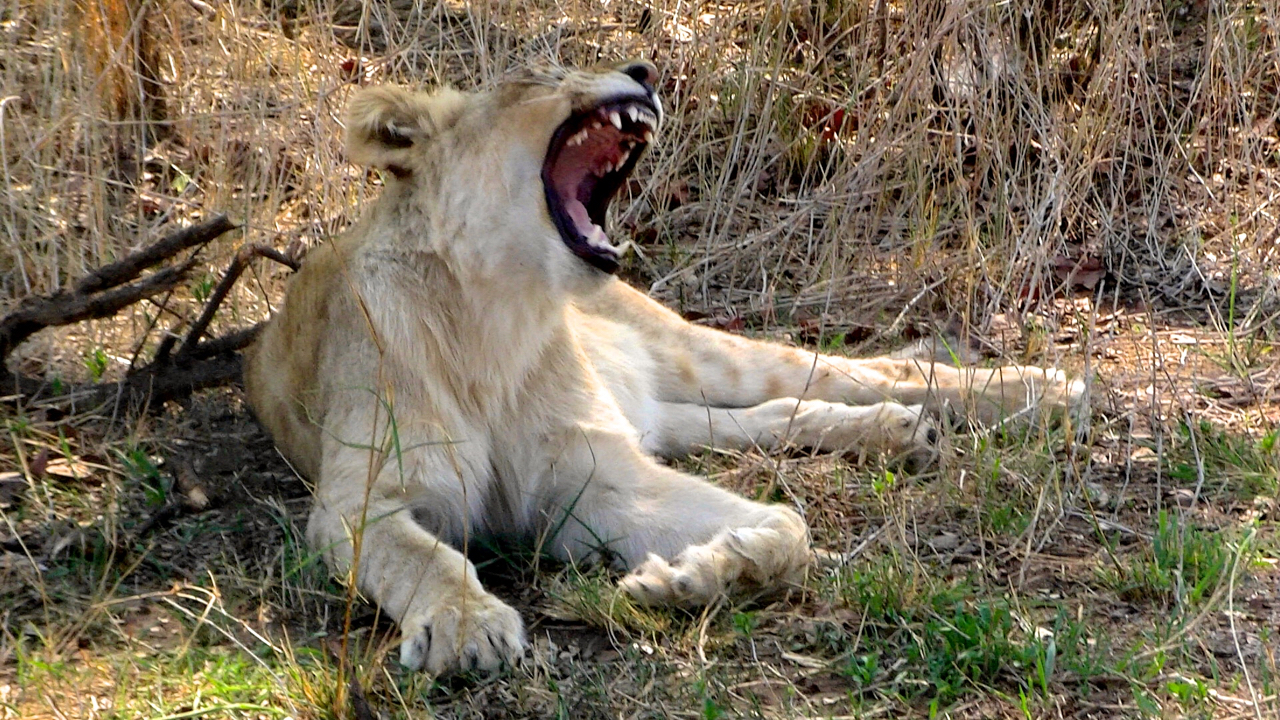
Ummm... What BIG teeth you have, my lion....
To start planning YOUR adventure through Zambia, click HERE......

